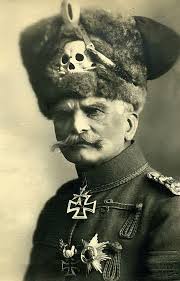 |
| Anton Ludwig August von Mackensen (1849 – 1945) |
If there had been a Ballon d’Or
equivalent for the WW1 season of 1915, General August von Mackensen would
surely have taken the award. This remarkable man lived to the age of 95, dying
in late 1945 under the Allied post war occupation of Germany. This was the
sixth Germanic era of his life: the Kingdom of Prussia; the North German
confederation; the German Empire (Second Reich); the Weimar Republic, and the
Third Reich being the others. Thus, he not only lived through the Austro-Prussian (1866) and Franco-Prussian (1870) wars that led to the
creation of the Second Reich; he served with success and distinction in WW1 and
survived WW2, outlasting the Third Reich.
He was ennobled in 1899, becoming von
Mackensen, on account of his distinguished military service to date. He was
seen as a likely successor to von Schlieffen as German Chief of Staff, but the
post went to Moltke the Younger in 1905. By the outbreak of war in 1914 he was
65 years old. He was assigned to command the XVII Army Corps as part of the
German Eighth Army under overall command of Prittwitz (the “fat soldier” we
encountered in earlier posts – Eastern Front Part Three). Along with Francois
and Below, Mackensen comprised the group of senior officers who overrode
Prittwitz’s decision to withdraw the Army towards the River Vistula. He fought
fiercely in the Battle of Gumbinnen to the north of the Masurian Lakes, and
thereafter starred at Tannenberg to the south of the lakes. Thus, he had
distinguished himself in action against both claws of the Russian pincer within
three months of the outbreak of war.
 |
| A younger version |
Hindenburg and Ludendorff replaced
Prittwitz, and when Hindenburg was made Supreme Commander East, he appointed
Mackensen as General of the Ninth Army to drive into the north of the Polish
Salient. He was awarded Prussia’s highest military decoration ‘Pour la Merite’
for his successful advances through Lodz and to the edge of Warsaw.
In April 1915 he took command of ‘Army
Group Kiev’, which included his own new Eleventh Army and, as we have seen, led
the vital German breakthrough between Gorlice and Tarnow in May, following this
up with the advances that pushed the whole Russian front back to the east of
Poland. He was further decorated for these acts, oak leaves added to his PlM,
and the Order of the Black Eagle, Germany’s highest ranking order of military
knighthood. He was not finished for 1915. In October 1915, Mackensen,
commanding the newly formed Heeresgruppe Mackensen, which included his
own German 11th Army plus the Austro-Hungarian 3rd Army and Bulgarian 1st Army
turned to the Balkan. The campaign effectively destroyed Serbia’s resistance,
although much of the Serbian Army was to retreat over the mountains to Albania,
where it was rescued by the British fleet and transferred to Salonika, re-entering
fighting on the Macedonian front. Mackensen respected the courage and
durability of the Serbian army, and erected a monument to them in Belgrade,
earning mutual respect from Serbia. He became Field Marshall after this campaign.
 |
| Mackensen reviewing Bulgarian troops 1916 |
We will encounter Mackensen again in
1916, at the head of Germany’s Rumanian campaign. Here after a brilliant
strategic and tactical campaign to halt Rumanian invasion of Transylvania (then
in Hungary) Mackensen continued to overrun Rumania, entering Bucharest on a
white horse at the head of his troops in November. For this Mackensen was
awarded Grand Cross of the Iron Cross.
At the end of the war he was captured in
fighting in northern Serbia, and interned until after Treaty of Versailles.
Mackensen retired from the army in 1920
at the age of 70. He was always a staunch monarchist, and was opposed to the
new Weimar Republic. He took advantage of his war hero status and frequently
appeared in public in full dress uniform in support of conservative and
military movements. His distinctive ‘totenkopf’ – death’s head - Hussar’s badge
was to be the symbol adopted by the Panzerwaffe and the SS during the Third
Reich.
 |
| The totenkopf badge |
Although he supported Hindenburg against Hitler in the 1932 general
election, he later became a visible and symbolic supporter of Hitler’s regime.
He disliked the violence and cruelty of the regime however, and reacted
publicly against the atrocities carried out in Poland in 1939-40.
Hitler and Goering came to view him as
disloyal but untouchable, and he outlasted both of them. His last high profile
public appearance was in full dress uniform at Kaiser Wilhelm’s funeral in
Holland in 1941.
Quite a life.
No comments:
Post a Comment